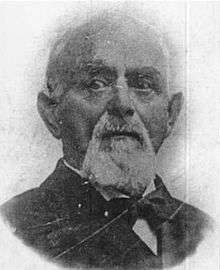Jacob W. Davis
| Jacob W. Davis | |
|---|---|
 Jacob Davis ca. 1905 | |
| Born |
Jacob Youphes (Jākobs Jufess) 1831 Riga, Russian Empire (now Latvia) |
| Died |
1908 San Francisco, California, United States |
| Citizenship |
Russian Empire United States |
| Occupation | Tailor, Inventor, and Entrepreneur |
| Known for | Invention of Jeans |
| Spouse(s) | Annie Davis (Parksher) |
| Children | 6 |
Jacob W. Davis (born Jacob Youphes, Latvian: Jākobs Jufess, Russian: Якоб Йофис) (1831–1908) was a Latvian-Jewish tailor and American immigrant[1] who is credited with inventing modern jeans.[2]
Early life
Jacob Youphes was born to a Jewish family in the city of Riga, then Russian Empire, today Latvia, in 1831. During his time in Riga city, he trained and worked as a tailor.[3]
Immigration to America
In 1854, at the age of 23, he emigrated from the Russian Empire to the United States, arriving in New York City where he changed his name to Jacob Davis. There he ran a tailors shop before moving to Maine and then, in 1856, San Francisco before moving on to Weatherville.
Time in Canada
After this itinerant spell in America, during which time it is believed he worked as a journeyman tailor, in 1858 Davis left California and moved to Western Canada to try to find more profitable work. There, Davis met a German immigrant, Annie Parksher, whom he married and together, Jacob and Annie had six children. During his time in Canada, Davis worked at the Fraser River panning for gold, as well as selling tobacco and wholesale pork in Virginia.[4]
Return to America
In January 1867, Davis returned to San Francisco with Annie and his family. Later that year, they moved to Virginia City, Nevada where he ran a tobacco store for a few months before beginning work once more as a tailor. By 1868, the family had moved, this time to Reno, Nevada which at that time was a tiny railroad town and there he helped Frederick Hertlein build a brewery. 1869 saw Davis revert to his original trade, opening a tailor shop in the main street of the town.[3]
Tailor shop in Reno
In his tailor shop, Davis made functional items such as tents, horse blankets and wagon covers for the railway workers on the Central Pacific Railroad. The fabric Davis worked with was a heavy duty cotton “duck” cloth and a heavy duty cotton “denim” cloth which he bought from Levi Strauss & Co. a dry goods company in San Francisco.[4] To strengthen the stress points of the sewn items he was making, Davis used copper rivets to reinforce the stitching.[3][5]
The birth of jeans
In December 1870, Davis was asked by a customer to make a pair of strong working pants for her husband who was a woodcutter.[6] To create suitably robust pants for working, he used duck cloth and reinforced the weak points in the seams and pockets with the copper rivets. Such was the success of these pants that word spread throughout the labourers along the railroad. Davis was making these working pants in duck cotton and, as early as 1871, in denim cotton. Before long, he found he could not keep up with demand.[4]
Patent application

Davis had previously applied for patents for other inventions.[7] Realising the potential value in his reinforced jeans concept, in 1872, he approached Levi Strauss, who was still his supplier of fabric, and asked for his financial backing in the filing of a patent application.[4] Strauss agreed, and on May 20. 1873, US Patent No. 139,121 for “Improvements in fastening pocket openings” was issued in the name of Jacob W. Davis and Levi Strauss and Company.[8] That same year, Davis started sewing a double orange threaded stitched design onto the back pocket of the jeans to distinguish them from those made by his competitors.[4] This trademark feature became Registered U.S. Trade Mark No.1,139,254.[9]
Working for Levi Strauss
By this time, Strauss had set up a sizeable tailor shop in San Francisco for the production of Davis' working pants and Jacob and his family had moved back to San Francisco for Davis to run this shop. As demand continued to grow, the shop was superseded by a manufacturing plant which Davis managed for Strauss. Davis continued to work there for the remainder of his life, overseeing production of the work pants as well as other lines including work shirts and overalls.[3]
Death
Davis died in San Francisco in 1908.
Commemoration
In 2006 a plaque was erected in Reno, Nevada, outside the premises where Davis's tailor shop was located, to commemorate the fact jeans were invented there.[6]
See also
External links
- Blue Jeans Jam - Celebrating Jacob Davis' inventing the riveted jeans
References
- ↑ "Jacob Davis: Pioneer Jewish Tailor of Nevada & His Copper Rivets That Made History". Jewish Museum of the American West. Jewish Museum of the American West. Retrieved 28 March 2015.
- ↑ Kelly, Kate. "The True Inventor of Blue Jeans". America Comes Alive. Kate Kelly, America Comes Alive. Retrieved 28 March 2015.
- 1 2 3 4 "Fascinating facts about Jacob Davis co-inventor of Blue Jeans in 1873". The Great Idea Finder. Retrieved 7 April 2014.
- 1 2 3 4 5 Jacob Davis and the Copper-riveted Jeans Archived December 21, 2010, at the Wayback Machine.
- ↑ Rocha, Guy. "Myth #38 - Levi's 501 Jeans: A Riveting Story in Early Reno". Just Goods. Retrieved 7 April 2014.
- 1 2 Loverin, Jan (2006), "A Nevada Stylist: Your Denim Jeans Are a Nevada Invention" (PDF), Nevada State Museum Newsletter, 36 (3): 4
- ↑ "Jacob Davis: His Life and Contributions" (PDF). Levi Strauss & Co. Retrieved 7 April 2014.
- ↑ U.S. Patent 139,121
- ↑ U.S. Trade Mark 1,139,254